Crossing the Atlantic in 1904: Notable Passengers of the SS Mesaba’s London–New York Voyage
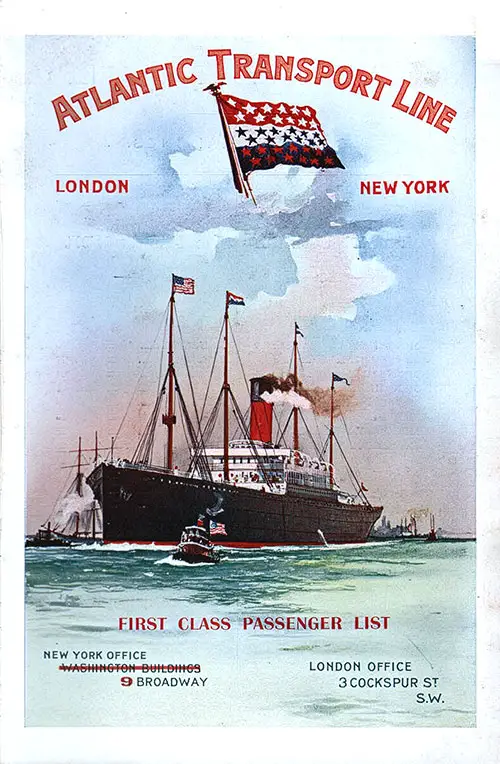
Front Cover, SS Mesaba First Class Passenger List, Departing 3 September 1904 from London to New York, Commanded by Captain J. Crichton. | GGA Image ID # 17311bce68
🚢 Review & Summary – SS Mesaba Passenger List (3 September 1904)
Voyage Overview
The SS Mesaba, operated by the Atlantic Transport Line, embarked on a first-class voyage from London to New York on 3 September 1904, under the command of Captain J. Crichton. This westbound transatlantic crossing connected Edwardian-era Britain with a rapidly industrializing United States, carrying an eclectic group of passengers—business leaders, socialites, academics, physicians, clergy, and entertainers.
The Mesaba was a steel-hulled passenger and cargo steamer launched in 1898 by Harland & Wolff. Though not the largest ship of her time, she was known for her comfort-focused first-class accommodations and steady service. Her name would later be immortalized in maritime history when, in 1912, she transmitted iceberg warnings to the RMS Titanic—messages that went unheeded.
⚙ Key Facts About the SS Mesaba
- Launched: 1898 by Harland & Wolff, Belfast
- Operator: Atlantic Transport Line
- Route: London ↔ New York (primary), with occasional calls at other ports
- Notable Event: Sent iceberg warnings to RMS Titanic in April 1912
- Service Type: Passenger and cargo, with emphasis on first-class comfort
Senior Officers and Staff
- Commander: Captain J. Crichton
- Surgeon: F. H. Douglas
- Chief Engineer: J. Robertson
- Chief Steward: C. Nickerson
First Class Passengers
- Mrs. H. M. Allen
- Miss H. M. Allen
- Miss Alice W. Allan
- Miss E. S. Adams
- Mrs. F. A. Angell
- Miss Amy Angell
- Mr. W. J. Battle
- Miss Helen B. Baker
- Miss Harriet J. Brown
- Miss M. S. Bowman
- Mrs. Brooker
- Miss H. M. Cady
- Miss Julia A. Clarke
- Mr. A. D. Compton
- Mr. Francis S. Connett
- Mr. A. N. Connett
- Miss Ellen W. McCorkle
- Miss Julia Chapins
- Miss Alice Dahn
- Mr. George A. Dallett
- Miss C. L. Dallett
- Mr. J. W. Fesler
- Miss Katherine Foy
- Miss Sophie Foy
- Miss Victoria Forrest
- Dr. Nathan W. Green
- Mrs. Nathan W. Green
- Mr. Elmer Gildersleeve, Jr.
- Mr. W. J. Harris
- Mrs. W. J. Harris
- Master W. J. Harris, Jr.
- Miss Effie J. Hart
- Miss B. Harris
- Miss J. L. Harris and Nurse
- Miss H. S. Hawley
- Miss Helen Hiscock
- Miss Constance B. Holt
- Mr. J. F. Hellmuth, K.C
- Mr. Fred G. Hellmuth
- Mrs. J. F. Hellmuth
- Miss Phyllis A. Hellmuth
- Mrs. Milton Humes
- Miss E. M. Johnston
- Miss Katherine Kennedy
- Miss Laura Kirk
- Mr. F. R. Kellogg
- Mrs. F. R. Kellogg
- Miss Marjoria Lauderdale
- Professor George T. Ladd
- Mrs. Ladd
- Mr. Lock
- Mr. Frank H. Lock
- Mrs. Frank Lock
- Miss K. N. Lock
- Miss H. B. Lock
- Miss Mary Lock
- Miss E. M. Lock
- Miss E. G. Lock
- Miss J. S. Marks
- Miss L. B. Masters
- Mr. M. N. Mennel
- Mrs. Mary S. Nichols
- Mr. Anton Oates
- Mrs. Anton Oates
- Mr. James Park
- Miss A. Roy Pett
- Mr. F. G. Reynolds
- Mr. Frank D. Richardson
- Mr. Harry Rochez
- Mrs. Harry Rochez
- Miss Lavinia S. Rose
- Mr. D. H. Saunders
- Miss H. M. Searles
- Miss Edith Shepard
- Mrs. J. W. Stevenson
- Miss Ada Sterling
- Mrs. R. J. Scoles
- Miss Mary E. Taylor
- Mr. C. T. Thompson
- Mrs. C. T. Thompson
- Miss Eleanor C. Thompson
- Miss Phoebe P. Thompson
- Mrs. Maria L. Thompson and Maid
- Mr. W. Thomson
- Miss Bessie Visel
- Mrs. M. Warren
- Mrs. Edward B. Watkinson
- Miss Helen L. Watkinson
- Miss Grace B. Watkinson
- Miss Mabel Warner
- Rev. Leighton Williams
- Mrs. Leighton Williams
- Miss Mary E. Woolley
- Miss Elsie May Williams
- Mrs. Rebecca Williams
- Miss Martha Wheeler
🧑🤝🧑 Notable Passengers & Historical Context
Academics & Intellectuals
Professor George T. Ladd – A distinguished philosopher and psychologist at Yale University, Ladd was instrumental in introducing Western philosophy to Japan during the Meiji era. His presence underscores the transatlantic exchange of academic ideas in the early 20th century.
Medical Professionals
Dr. Nathan W. Green – A respected American physician, traveling with his wife, possibly for both leisure and professional networking in an age when medical conferences often crossed oceans.
Clergy & Religious Figures
Rev. Leighton Williams – A notable Baptist clergyman and social reformer from New York, known for his progressive stance on labor rights and education, reflecting the era’s growing Social Gospel movement.
Cultural & Social Elites
Mrs. Rebecca Williams – Likely connected to influential social circles in New York City.
Elmer Gildersleeve, Jr. – From the prominent Gildersleeve family, involved in New York’s publishing and education circles.
Mrs. F. R. Kellogg – Connected to the influential Kellogg family, prominent in business and philanthropy.
Biography Briefs
Professor George T. Ladd
George Trumbull Ladd (1842–1921) was an influential American philosopher, educator, and psychologist, serving as Clark Professor of Metaphysics and Moral Philosophy at Yale University from 1881 to 1901 (Wikipedia, Encyclopedia Britannica). A trailblazer in experimental psychology, he established one of the first U.S. psychological laboratories at Yale and authored widely used texts such as Elements of Physiological Psychology (Online Books Page, Encyclopedia Britannica, Wikipedia). Beyond academia, Ladd was deeply involved in cross-cultural exchange—mos notably lecturing in Japan, advising its government on educational reform, and receiving high honors such as the Order of the Rising Sun (lux.collections.yale.edu, Wikipedia, ijip.in).
Rev. Leighton Williams
Reverend Leighton Williams appears in the passenger list as a First Class travel participant. Although deeper biographical sources are scarce, his designation “Rev.” and presence among elite transatlantic travelers suggest he was likely a socially prominent clergyman—perhaps involved in the Social Gospel movement prominent among urban Protestant ministers in early 20th-century America, advocating for social reforms and community welfare (cambridge.org).
Dr. Nathan W. Green
Dr. Nathan W. Green, listed among the First Class passengers, was a respected physician traveling with his wife—reflecting the early 1900s trend of medical professionals using transatlantic travel for both professional and personal reasons. While no deeply specific biographical sources were identified, his inclusion among other distinguished passengers underscores the rising social standing and mobility of physicians in Edwardian-era America.
🎯 Engaging Aspects of This Passenger List
What makes this passenger list particularly compelling is its cross-section of Edwardian society—from pioneering professors and reform-minded clergy to high-society families bridging old-world Europe and the dynamic American East Coast. This was not simply a voyage of leisure; it was a networking platform for thought leaders, social reformers, and business elites.
Information For Passengers
Tea and Coffee at 7:00 am
Breakfast ... 8:30 am
Lunch ... 1:00 pm
Dinner ... 7:00 pm
Meals for Nurses and Children :—Breakfast, 8:00 am; Dinner, 12 noon; Tea, 5:00 pm
I lease apply to Second Steward for seating accommodation at Table. Lights in the Saloon are extinguished at 11:00 pm, and in the Smoking Room at 11:30 pm
Bar closes at 11:00 pm
Smoking is not allowed in the Saloon, State-rooms or Companion-ways.
The Saloon Steward will supply Stamps, Telegraph Forms, Books of Reference, and Railway Time Tables of the Principal Companies.
Divine Service.—Intimation regarding Divine Service will appear on the Notice Boards every Sunday morning.
Valuables.—Passengers are enjoined to be very careful in the disposal of small articles of baggage, more especially during Embarkation, when there are always strangers on Board. Money, Jewellery, and valuables of any kind, should always be left securely under lock and key.
Passengers may deposit with the Purser any Money, Jewellery, &c., for safe keeping during the voyage, but no responsibility can be accepted for same.
For the convenience of Passengers the Purser is prepared to exchange a limited amount of English and American money. The rate of exchange will be $4.80 to the ,Cr when giving American in exchange for English currency, and :'I to $4.95 when giving English money for American.
Luggage.—Only hand-bags and trunks which will fit underneath the berths are allowed in the State-rooms; all large or heavy luggage must be placed in the Baggage Room, to which access can be gained by applying to the Officer in charge of Baggage.
Passengers will greatly expedite the disembarkation if they will have their State-room Baggage packed ready for removal directly on arrival, so that the transfer may at once be proceeded with.
Electric Bell Calls.—For Steward, one ring; for Stewardess, two rings.
Passengers' Addresses should be left with the Purser, in order that any letters sent to the care of the Company may be forwarded.
Letters.— Passengers may have their letters addressed to any of the Company's Offices given below, where they will be retained until called for, or forwarded according to instructions.
Atlantic Transport Line Offices,
Atlantic Transport Co., Ltd. 3, Cockspur Street, London, S.W.
N. Martin, Agent ... 9, Rue Scribe, Paris.
Atlantic Transport Co.
New York-9, Broadway.
Baltimore—boo, North Charles Street.
Philadelphia-311, Bourse Building.
Chicago-4, Sherman Street.
Minneapolis-412. Guaranty Loan Building
📚 Relevance of the SS Mesaba Voyage
For teachers, this document is a tangible way to explore transatlantic migration, tourism, and cultural exchange in the pre-WWI era.
For students, it provides real names and dates that can anchor historical research projects.
For genealogists, it is a vital link in tracing the movements of prominent families and professionals.
For historians, the voyage captures a moment in time when the Atlantic crossing was both a practical necessity and a mark of social standing.
💭 Final Thoughts – Why This Passenger List Matters
The 3 September 1904 voyage of the SS Mesaba is more than just a roster of travelers—it’s a snapshot of Edwardian transatlantic society. Each name represents a story, a purpose for travel, and a connection between continents. Whether you’re an academic, a genealogist, or simply a history enthusiast, this passenger list offers a richly detailed lens into the people who shaped the cultural and intellectual fabric of the early 20th century.
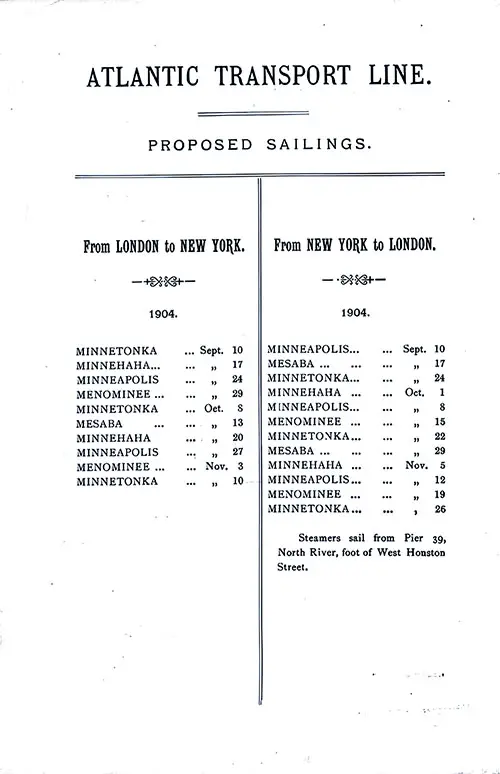
Saling Schedule, London-New York, from 10 September to 26 November 1904. Ships Included the Mesaba, Minnehaha, Minneapolis, Minnetonka, and Menominee. SS Mesaba First Class Passenger List, 3 September 1904. | GGA Image ID # 22b5f30637
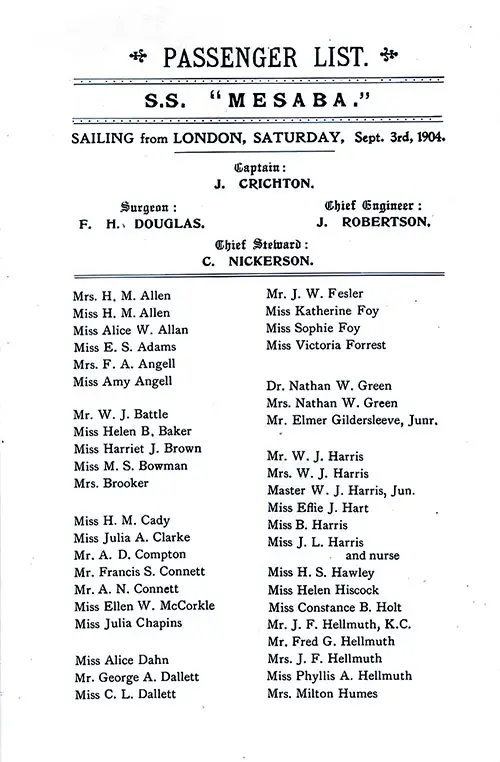
Listing of Senior Officers and List of Passengers, Part 1 (Allen-Humes), SS Mesaba First Class Passenger List, 3 September 1904. | GGA Image ID # 22b63d3f16
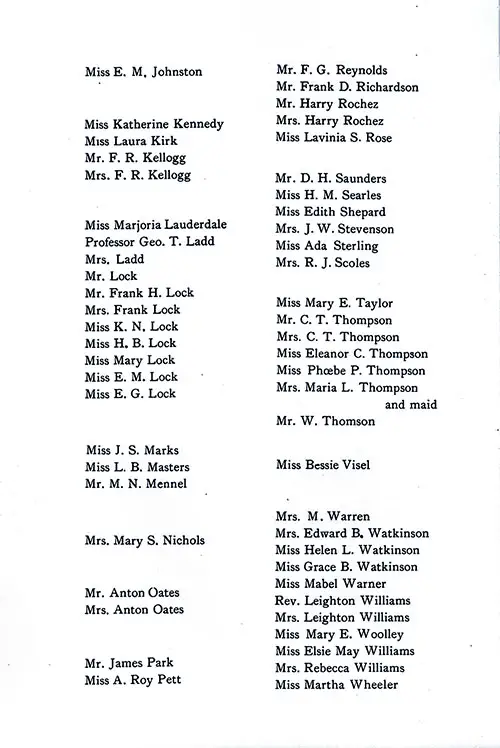
List of Passengers, Part 3 (Johnston-Wheeler), SS Mesaba First Class Passenger List, 3 September 1904. | GGA Image ID # 22b6c9422d
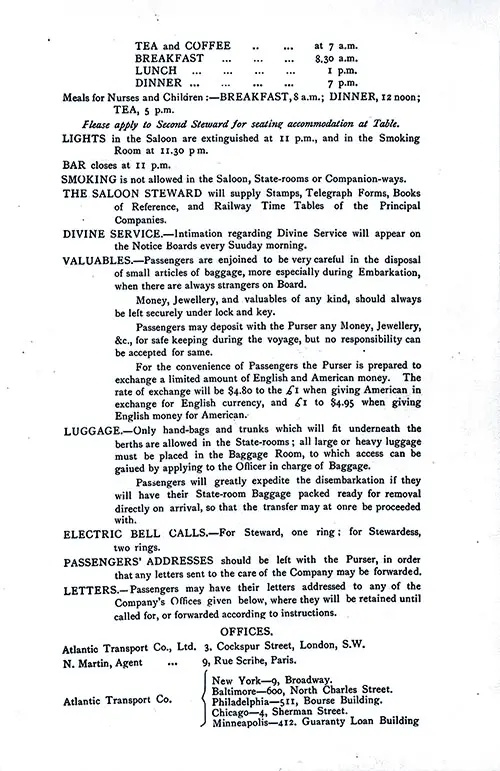
Information for Passengers and ATL Offices, SS Mesaba First Class Passenger List, 3 September 1904. | GGA Image ID # 22b6ccca6d

Atlantic Transport Line Track Chart of the North Atlantic and Memorandum of Log (Unused). SS Mesaba First Class Passenger List, 3 September 1904. An Unused Memorandum of Log, Offering Passengers a Way to Track Progress Across the North Atlantic—a Charming Remnant of Pre-Digital Navigation Culture. | GGA Image ID # 22b6db6a95
📜 Research note: Some names and captions were typed from originals and may reflect period spellings or minor typographical variations. When searching, try alternate spellings and cross-check with related records. ⚓
Curator’s Note
For over 25 years, I've been dedicated to a unique mission: tracking down, curating, preserving, scanning, and transcribing historical materials. These materials, carefully researched, organized, and enriched with context, live on here at the GG Archives. Each passenger list isn't just posted — it's a testament to our commitment to helping you see the people and stories behind the names.
It hasn't always been easy. In the early years, I wasn't sure the site would survive, and I often paid the hosting bills out of my own pocket. But I never built this site for the money — I built it because I love history and believe it's worth preserving. It's a labor of love that I've dedicated myself to, and I'm committed to keeping it going.
If you've found something here that helped your research, sparked a family story, or just made you smile, I'd love to hear about it. Your experiences and stories are the real reward for me. And if you'd like to help keep this labor of love going, there's a "Contribute to the Website" link tucked away on our About page.
📜 History is worth keeping. Thanks for visiting and keeping it alive with me.
